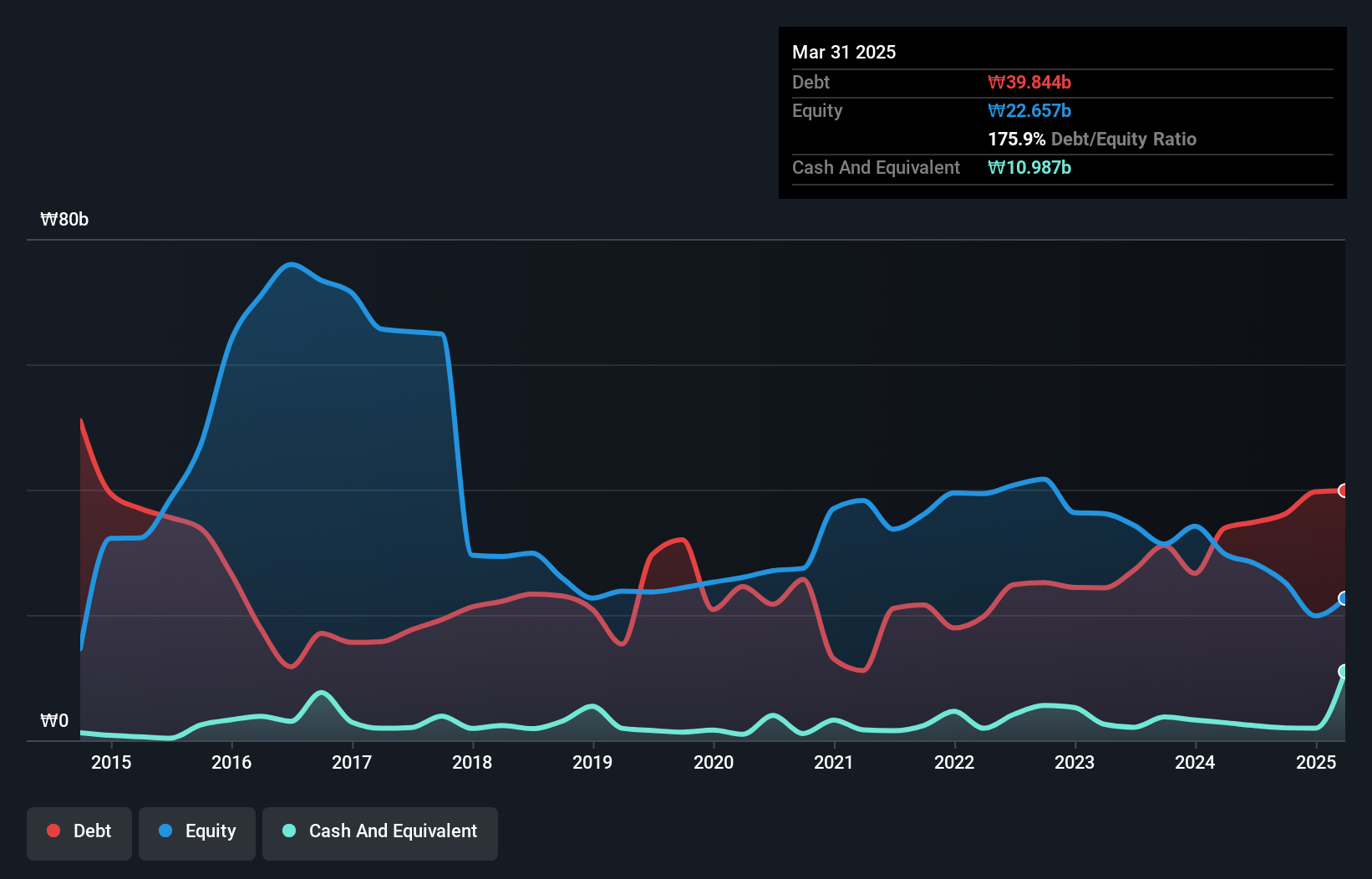- South Korea
- /
- Entertainment
- /
- KOSDAQ:A051780
Health Check: How Prudently Does CUROHOLDINGS (KOSDAQ:051780) Use Debt?
Legendary fund manager Li Lu (who Charlie Munger backed) once said, 'The biggest investment risk is not the volatility of prices, but whether you will suffer a permanent loss of capital.' When we think about how risky a company is, we always like to look at its use of debt, since debt overload can lead to ruin. We note that CUROHOLDINGS Co., Ltd. (KOSDAQ:051780) does have debt on its balance sheet. But should shareholders be worried about its use of debt?
Why Does Debt Bring Risk?
Debt and other liabilities become risky for a business when it cannot easily fulfill those obligations, either with free cash flow or by raising capital at an attractive price. Ultimately, if the company can't fulfill its legal obligations to repay debt, shareholders could walk away with nothing. However, a more frequent (but still costly) occurrence is where a company must issue shares at bargain-basement prices, permanently diluting shareholders, just to shore up its balance sheet. Having said that, the most common situation is where a company manages its debt reasonably well - and to its own advantage. The first step when considering a company's debt levels is to consider its cash and debt together.
How Much Debt Does CUROHOLDINGS Carry?
You can click the graphic below for the historical numbers, but it shows that as of March 2025 CUROHOLDINGS had ₩39.8b of debt, an increase on ₩33.9b, over one year. However, it also had ₩11.0b in cash, and so its net debt is ₩28.9b.

How Strong Is CUROHOLDINGS' Balance Sheet?
According to the last reported balance sheet, CUROHOLDINGS had liabilities of ₩50.9b due within 12 months, and liabilities of ₩11.4b due beyond 12 months. Offsetting this, it had ₩11.0b in cash and ₩3.39b in receivables that were due within 12 months. So its liabilities total ₩47.9b more than the combination of its cash and short-term receivables.
This deficit casts a shadow over the ₩20.8b company, like a colossus towering over mere mortals. So we definitely think shareholders need to watch this one closely. At the end of the day, CUROHOLDINGS would probably need a major re-capitalization if its creditors were to demand repayment. When analysing debt levels, the balance sheet is the obvious place to start. But you can't view debt in total isolation; since CUROHOLDINGS will need earnings to service that debt. So if you're keen to discover more about its earnings, it might be worth checking out this graph of its long term earnings trend.
Check out our latest analysis for CUROHOLDINGS
Over 12 months, CUROHOLDINGS made a loss at the EBIT level, and saw its revenue drop to ₩62b, which is a fall of 19%. We would much prefer see growth.
Caveat Emptor
While CUROHOLDINGS's falling revenue is about as heartwarming as a wet blanket, arguably its earnings before interest and tax (EBIT) loss is even less appealing. Indeed, it lost a very considerable ₩9.0b at the EBIT level. When we look at that alongside the significant liabilities, we're not particularly confident about the company. We'd want to see some strong near-term improvements before getting too interested in the stock. It's fair to say the loss of ₩16b didn't encourage us either; we'd like to see a profit. In the meantime, we consider the stock to be risky. There's no doubt that we learn most about debt from the balance sheet. However, not all investment risk resides within the balance sheet - far from it. To that end, you should learn about the 4 warning signs we've spotted with CUROHOLDINGS (including 2 which are potentially serious) .
Of course, if you're the type of investor who prefers buying stocks without the burden of debt, then don't hesitate to discover our exclusive list of net cash growth stocks, today.
New: AI Stock Screener & Alerts
Our new AI Stock Screener scans the market every day to uncover opportunities.
• Dividend Powerhouses (3%+ Yield)
• Undervalued Small Caps with Insider Buying
• High growth Tech and AI Companies
Or build your own from over 50 metrics.
Have feedback on this article? Concerned about the content? Get in touch with us directly. Alternatively, email editorial-team (at) simplywallst.com.
This article by Simply Wall St is general in nature. We provide commentary based on historical data and analyst forecasts only using an unbiased methodology and our articles are not intended to be financial advice. It does not constitute a recommendation to buy or sell any stock, and does not take account of your objectives, or your financial situation. We aim to bring you long-term focused analysis driven by fundamental data. Note that our analysis may not factor in the latest price-sensitive company announcements or qualitative material. Simply Wall St has no position in any stocks mentioned.
About KOSDAQ:A051780
CUROHOLDINGS
Engages in the entertainment and coffee businesses in South Korea.
Good value with slight risk.
Market Insights
Community Narratives



